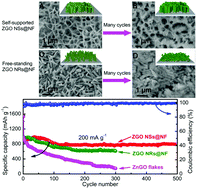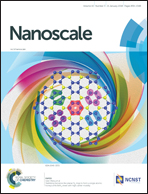CTAB-assisted growth of self-supported Zn2GeO4 nanosheet network on a conductive foam as a binder-free electrode for long-life lithium-ion batteries†
Abstract
The Ge-based compounds show great potential as replacements for traditional graphite anode in lithium-ion batteries (LIBs). However, large volume changes and low conductivity of such materials result in a poor electrochemical cycling and rate performance. Herein, we fabricate a self-supported and three-dimensional (3D) sponge-like structure of interlinked Zn2GeO4 ultrathin nanosheets anchored vertically on a nickel foam (ZGO NSs@NF) via a simple hydrothermal process assisted by cetyltrimethyl ammonium bromide (CTAB). Such robust self-supported hybrid structures greatly improve the structural tolerance of the active materials and accommodate the volume variation that occurs during repeated electrochemical cycling. As expected, the self-supported ZGO NSs@NF composites demonstrate an excellent lithium storage with a high discharge capacity, a long cycling life, and a good rate capability when used as binder-free anodes for LIBs. A high reversible discharge capacity of 794 mA h g−1 is maintained after 500 cycles at 200 mA g−1, corresponding to 81% capacity retention of the second cycle. Further evaluation at a higher current density (2 A g−1) also delivers a reversible discharge capacity (537 mA h g−1) for this binder-free anode. This novel 3D structure of the self-supported ultrathin nanosheets on a conductive substrate, with its volume buffer effect and good interfacial contacts, can stimulate the progress of other energy-efficient technologies.

- This article is part of the themed collection: International Year of the Periodic Table: Elements for Next Generation Batteries


 Please wait while we load your content...
Please wait while we load your content...